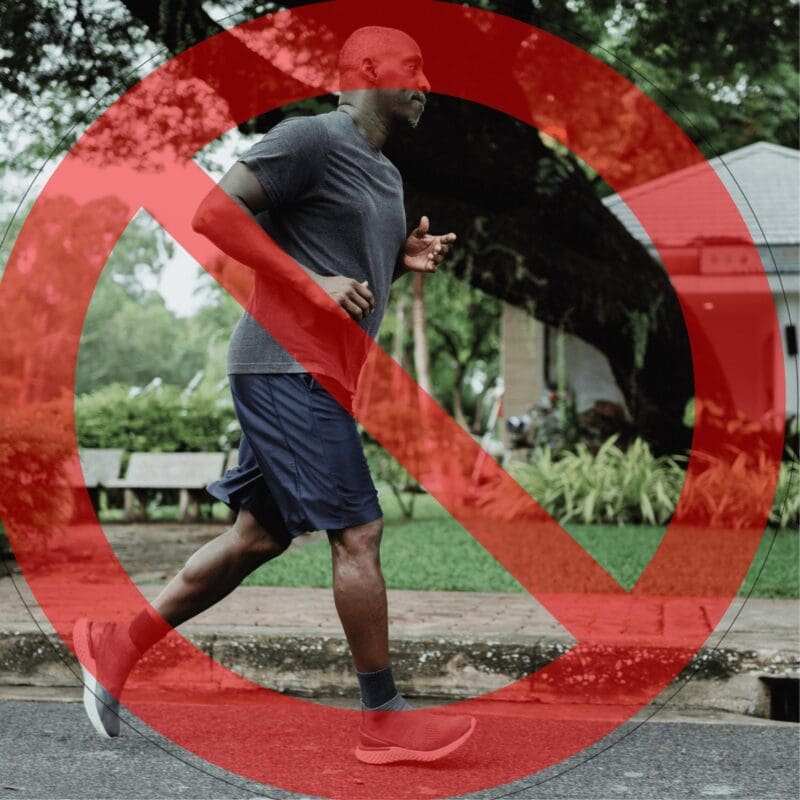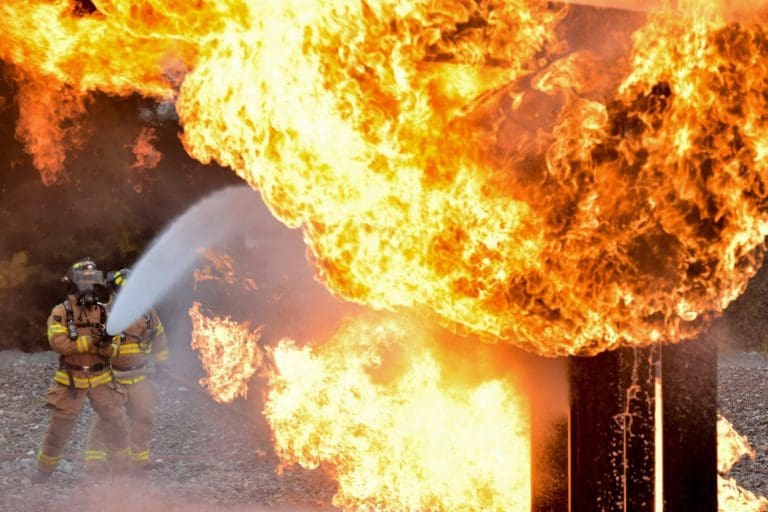What is the best cardio workout for big guys in the fire service without running
As I was contemplating life while trying to catch my breath, without breathing through all of my air too quickly while advancing a charged hose line as the backup firefighter to the nozzle man ahead of me. I wanted to find out how I can be in better cardio shape, so that I’m not gassed trying to push the hose line, and not become a hazard to my team. So what is the best cardio workout for big guys in the fire service without running?
The best way to increase cardio as a big guy without running, is to figure out a way to make your heart pump just as hard and as long as the activity you need to be able to perform. When you have your turnout gear on and are doing something physically demanding, your heart is pumping hard and fast due to the increased demand of oxygen from your muscles. I’m not a doctor or a scientist, but I will show you things that I have done that have helped me be in better cardio shape, without hurting my joints by pounding the pavement.
Traditional cardio vs firefighting specific cardio

We all know traditional cardio, of either running for long distances out on a track, the road or treadmill. I just want to say that these forms of cardio do have their appropriate time and place, and should not be completely eliminated from your routine, but at the same time, does not need to be a staple. One reason that medium and long distance running has been a fan favorite for decades is because of the way it makes your heart work in order to get blood to your brain and your muscles. The more efficient your heart can pump oxygenated blood (blood with fresh oxygen) to your muscles, brain, and all the other tissues that need it, the less difficult that task that you are doing appears to be.
With firefighting, you really are not ever running on the fireground. This does not mean that you are not moving with a purpose. I want you to visualize what the fireground would look like. There will be multiple teams (companies) of other firefighters with specific job functions directed by the incident commander (usually a battalion chief or another officer). Let’s say your company is responsible for the door. Being the door team, you and your team need to be able to breach the door with very specific tools. You need to breach this door as soon as possible so that a hose team can get in there and start spraying water. Once this door is breached, you have to get on your stomach and crawl into the space that the door was at, to feel for potential victims who did not make it to the door.
In this scenario alone, you have your heavy bunker gear on, then you have your SCBA (self contained breathing apparatus, a.k.a your breathing pack), and then you have some heavy steel tools like an axe, and a halligan, and if you do find a victim, you have to pull them and your weight with your equipment combined. All while dealing with some mind boggling heat, that will sap your energy so quickly.
As a firefighter you need to be very strong, but more importantly, have superior muscular stamina. If your muscles tire out quickly, your demand for oxygen increases, and you run the risk of going through your bottle of oxygen too quickly.
Heat, especially in a structure fire, has the ability to bring you to your knees, no matter how great in cardio shape you may be. Knowing this alone will show you the importance of training past your comfort zone, because due to all these factors I pointed out that happen in working fires, you will always perform a lot worse than you are used to cardio wise.
As a firefighter, you need to be able to perform tasks that require strength, for long periods of time.
Know your target heart rate zone

This is something I overlooked for many many years, because I never really understood the point of it. Look, I’m far from a small guy. I’m 6 foot and weigh 275 lbs. I’m mostly muscle, but got some fat. I like my size and so does my wife, so I plan on keeping it. I like to think I’m pretty strong, but I am not a fan of running, because it tends to hurt my knees. Knowing where my heart rate needs to be to get the most out of cardio training is important. I’m still nowhere near an expert in heart rate zones, but this is what I did to figure out my goal heart rate. I went on a 2 mile run/walk run, and at the end of it, I took my pulse rate. So if my pulse rate while I was running is about 120 beats per minute, I want to find an exercise or routine that will get me to 120 bpm without having to run.
In case you are unsure about how to take a pulse, the way you do it, is to find your radial artery. This is located on your wrist, close to the meat of your thumb

And you count how many beats you feel for 30 seconds. Once you have that number, multiply it by 2, and you have your heart rate.
The way you will use this is find an exercise or routine, that will get your heart pumping. Once you are at that window or zone, keep your heart rate there for about a good 30-40 minutes, and your golden.
HIIT Cardio

f you’ve been working out for any period of time, there is a very good chance that you have heard of High Intensity Interval Training (HIIT). Many like it, some prefer steady state cardio, but it is extremely effective for our profession. There are many moments that you are going from 0 – 100mph in the fire service, so training like you play is very important. Some of my favorite types of HIIT cardio are Tabata routines, Every minute on the minute(EMOM), and For Time.
Tabata
The way tabata works is exactly as interval training. I know it was named after it’s creator, but the way I understand it is a form of interval training. A sample tabata interval would be doing hard intense work for a brief period, followed by a brief rest period. So a burpee tabata could look like this. 20 seconds of explosive and quick burpees, followed by 40 seconds of rest. And you do about 10 – 20 sets of this. I personally love doing this with an airbike/assault bike. As you get stronger/fitter, you can increase your work time, decrease rest time or both.
Every Minute On The Minute
This HIIT interval is exactly what it sounds like. At the minute mark, you do an exercise or a certain amount of reps of an exercise. An example of this would be 3 deadlifts every minute for 10 minutes. It may sound easy at first, but the more fatigued you become, and the slower you get, the less rest time you will end up having. It’s not uncommon on set 1 to have about 45 seconds of rest remaining, and towards the end you get about 15 seconds of rest. This of course all depends on the reps, the sets and your fitness level.
For Time
This is the type of interval that is good if you are trying to beat your time after performing a certain set of exercises. The CPAT for example would be an event “for time”. You can perform 20 burpees, 10 med ball slams, 5 pulls up, and 100 meter run. And attempt to get as many rounds of those as possible. And attempt to beat your time every time you do it.
Personal favorite equipment

By far my favorite pieces of equipment to use to build my cardio are the assault/air bike and battle ropes. Both of these are really intense, and life just sucks when doing them, no matter your fitness level. With the assault bike, the harder or faster you pedal, the more resistance you get in turn. The assault bike is literally a fan powered by your pedaling. So the faster that you go, the harder it is to move air at that speed.
Battle ropes are very heavy, and not only challenge your cardiovascular fitness, it also challenges your core. When you swing the battle rope, it attempts to pull you towards it. If you let it do that to you, there’s a good chance you can eat some pavement. So your core has to stabilize you, keeping you upright while resisting going forward.
Conclusion
I hate running with a healthy passion, but it has its place. In a box stuffed deep in my closet. If you dislike running, or you cannot run for medical reasons, try to find an activity that will get your heart rate to that specific zone, where the heart starts becoming efficient in delivering oxygen to your body. These exercises that I mentioned here, are all things I do in order to keep in decent cardio shape, without needing to go out for a long run. I do run, because the department i’m with will make me run from time to time. So running here and there will build the muscular leg endurance that I need for the run. I’d rather have my legs hurt, rather than gasping for air, feeling like I can’t get enough air in my lungs.
If you would like to learn more about some exercises you can do today to start increasing your cardio and your strength, specific for firefighting, click the button below.








Once again great content man. Very helpful to know I don’t have to Kill myself running
Thanks a lot Jerry. And I completely agree, and this is how I keep up on my cardio